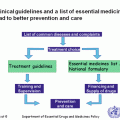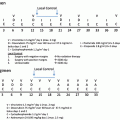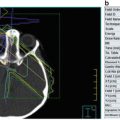Table 9.1
Some potential causes of mediastinal tumors in children
Etiology | Anterior mediastinal masses | Middle mediastinal masses | Posterior mediastinal masses |
|---|---|---|---|
Malignant | Non-Hodgkin lymphomas | Non-Hodgkin lymphomas | Neuroblastoma |
Hodgkin lymphoma | |||
Teratoma | Kaposi sarcoma | ||
Kaposi sarcoma | |||
Benign | Tuberculosis | Tuberculosis |
Signs and Symptoms
Symptoms and signs include cough, facial swelling, dyspnea, orthopnea, fatigue, and less frequently headache, dizziness, visual disturbances, hoarseness, and dysphagia [6, 7]. Symptoms can worsen abruptly when the patient is supine and improve when in the prone position. Physical examination findings can include edema of the head, neck, and upper extremities; venous distension; laryngeal edema; stridor; wheezing and anxiety.
Diagnosis
Symptoms and physical examination are sufficient to suspect the diagnosis of SVC or CAC syndrome, but patients with severe obstruction may be asymptomatic. Mediastinal masses compressing critical structures constitute an emergency even in patients with no symptoms or signs, and must be ruled out in any patient with suspected leukemia or lymphoma. A chest radiograph is sufficient to identify clinically important mediastinal masses, but rarely shows the degree of obstruction because most masses occur in the anterior mediastinum so that the tracheal width is normal. A lateral radiograph can sometimes show antero-posterior narrowing, but is neither sensitive nor specific. Chest radiography is useful for newly diagnosed patients because it can also identify pleural or pericardial effusions that may necessitate urgent intervention. Chest computed tomography (CT) allows adequate anatomical description of the mass and neighboring structures, and quantifies the degree of tracheal compression, and thus the risk of complete obstruction and sudden death. Such evaluation is critical to facilitate decisions regarding sedation or anesthesia.
Immediate Management
Great caution must be exercised during every phase of initial evaluation, since patients with CAC syndrome are at risk for worsened compression and sudden death. Painful procedures, or anything that increases patient anxiety, should be avoided, since rapid inspiration can decrease pressure in the airways and precipitate collapse, which can be difficult to reverse. When transporting the patients to the radiology department, they should remain in upright position and the initial CT should be performed with the patient in the prone position to avoid worsening compression.
The main aim of management is to secure the airway of the patient and alleviate respiratory distress by maintaining an upright or prone position, or bed rest with elevation of the upper part of the body. These positions, and sometimes the left lateral decubitus position, help lift an anterior mediastinal mass off the airways and right ventricular outflow tract. Inability to tolerate the supine position is an ominous sign, and the supine position should be avoided. Patients with respiratory distress may feel better with oxygen via facemask, but if this increases anxiety it may be counterproductive.
If the patient experiences distress, he should be immediately placed in the prone position so that gravity will pull the mass away from the airways. If complete tracheal compression occurs, intubation is usually not possible without a rigid bronchoscope, so patients should be placed prone during any resuscitation attempt, since prone positioning itself may sometimes be sufficient to open the airway. Adequate IV access is important, but is not helpful in a resuscitation attempt, since opening the airway and relieving right ventricular outflow tract obstruction are the only measures that can reverse cardiac or respiratory arrest caused by a mediastinal mass.
Definitive Management
Making a correct diagnosis using the least invasive method possible and immediate initiation of appropriate therapy are the top priorities. A complete blood count and peripheral blood smear is noninvasive and can often diagnose acute leukemia. Pleural fluid aspiration using local anesthesia is also not very invasive, and cytology of pleural fluid is sufficient to diagnose T-cell lymphomas in many cases. Bone marrow aspiration or biopsy of a peripheral lymph node or testicular mass, if present, can also be performed under local anesthesia, but in some cases the only site of disease is the mediastinum, and the mass must be biopsied by an interventional radiologist or thoracic surgeon, with the attendant procedural and anesthetic risks. Empiric therapy (e.g., glucocorticoids) can lead to rapid improvement of symptoms in patients with lymphomas or acute leukemias, but the mass may shrink rapidly and make subsequent diagnosis and disease-specific therapy impossible, so every effort should be made to obtain a histological diagnosis prior to starting therapy.
If emergent antineoplastic therapy is needed to save the life of the child prior to making a diagnosis, radiotherapy to the central mediastinum (if available) using a daily dose of 2–4 Gy can lead to clinical improvement within 18 h. The radiation port can be limited so that peripheral disease is spared and thus available for biopsy when the patient’s clinical condition has improved. If radiation-induced edema occurs, symptoms and signs may worsen and necessitate glucocorticoid therapy. In life-threatening cases for whom emergent radiation therapy is not possible, empiric treatment with intravenous methylprednisolone 50 mg/m2/day in four divided doses may rapidly reduce the size of the mass and associated edema. Chemotherapy with cyclophosphamide, an anthracycline, vincristine, and prednisone (CHOP) can also be considered. Note that even when a residual mass is present and available for biopsy, prior glucocorticoids, chemotherapy or radiotherapy could change the histological findings and make it difficult to establish a definitive histological diagnosis.
Pericardial Effusion and Cardiac Tamponade
Although pericardial effusion is often asymptomatic, it represents an oncologic emergency when it causes cardiac tamponade [8, 9].
Pathophysiology
Pericardial effusion is seen with a variety of tumors including lymphomas and metastatic solid tumors and results from inflammation of the pericardium, obstruction of lymphatic drainage from the pericardium, or fluid overload. Malignant involvement of the pericardium rarely may be primary, but is usually secondary to spread from a nearby or distant focus of malignancy, which can involve the pericardium by contiguous extension from a mediastinal mass, nodular tumor deposits from hematogenous or lymphatic spread, and diffuse pericardial thickening from tumor infiltration (with or without effusion). In diffuse pericardial thickening the heart may be encased by an effusive-constricted pericarditis, but this is rare in children.
Symptoms, Signs, and Diagnosis
Pericardial effusion is usually asymptomatic, and most often diagnosed incidentally during evaluation of newly diagnosed cancer, and confirmed by echocardiogram. When the effusion is caused by pericarditis, patients often have chest pain and dyspnea, but otherwise usually effusions are asymptomatic unless they cause cardiac tamponade, defined as the inability of the ventricle to maintain cardiac output because of extrinsic pressure. Note that cardiac tamponade can also be caused by a mediastinal mass or an intrinsic mass. Fortunately, tamponade is rare in children with cancer. Findings in patients with tamponade resemble those of heart failure, including shortness of breath, cough, palpitations, chest pain improved by sitting, and nonspecific abdominal pain. Physical examination findings include tachycardia, low blood pressure, jugular venous distension, pulsus paradoxus, soft heart sounds, pericardial rub, and signs of low cardiac output, such as poor peripheral perfusion.
Investigations
In patients with significant pericardial effusions, the chest X-ray shows enlargement of cardiac silhouette, ECG demonstrates low voltage QRS complexes, and flattened or inverted T waves, and echocardiography shows the volume of pericardial effusion and whether there is atrial or ventricular collapse with hemodynamic compromise.
Treatment
Most patients can be treated by treating the underlying malignancy, but in those with refractory disease or life-threatening tamponade, a pericardial tap for one-time aspiration of fluid or percutaneous catheter drainage under echocardiographic guidance or fluoroscopic guidance may be considered. Fluid should be evaluated for malignant cells, which may affect treatment and prognosis of the underlying cancer.
Pleural Effusion
Pleural effusions can occur at diagnosis in children with lymphomas, and the effusion is usually malignant in patients with non-Hodgkin lymphomas and nonmalignant in those with Hodgkin lymphoma [10–12]. Effusions can also be caused by fluid overload with congestive cardiac failure, low albumin, infections (e.g., empyema, tuberculosis), and toxicity of chemotherapy (e.g., dasatinib, methotrexate, procarbazine, cyclophosphamide, bleomycin). Although pleural effusion is rarely life-threatening, sizeable and rapid accumulation of fluid can compress lung parenchyma and cause respiratory insufficiency.
Clinical Presentation and Evaluation
Symptoms are related more to the rate of pleural fluid accumulation rather than total volume of fluid, and can include dyspnea, orthopnea, cough, and pleuritic chest pain. The presence of fever suggests atelectasis or infection. Diagnosis can be suspected when basilar breath sounds are absent and the patient has shifting dullness to percussion [12]. Chest X-ray with lateral decubitus views can confirm the presence of a pleural effusion and estimate its extent. Ultrasonography and CT may be useful to differentiate fluid loculations from pleural masses, and should be performed if biopsy is planned to assure that the biopsy site is representative of the pathologic process.
Management
Small or asymptomatic effusions require no treatment and resolve once the underlying cause is addressed [10, 11]. Large, symptomatic effusions causing respiratory distress can be drained by thoracentesis. Initial drainage can be performed manually using a large bore needle, attached to a three-way stopcock and a large volume syringe. This may be followed by insertion of tube for more complete drainage if the patient is at risk for re-accumulation.
Spinal Cord Compression
Epidural spinal cord compression can occur in patients with a variety of solid tumors and in approximately 0.4 % of patients with newly diagnosed acute leukemia [13]. The spinal cord can be compromised at any site, but in children the thoracic vertebral segment is most often affected. Vertebral collapse resulting from tumor invasion of the vertebral bodies can also compromise the spinal cord. Symptoms and signs can include numbness, tingling, paresthesia, progressive pain at the level of the epidural lesion, radicular pain, weakness or paralysis of the upper and lower extremities, and neurogenic bladder. Deep tendon reflexes are hyperactive, and the Babinsky response is extensor.
Diagnosis and Treatment
Spinal cord compression is a medical emergency and should be evaluated promptly. Plain films and CT scans are not sensitive enough to identify spinal cord compression, so magnetic resonance imaging should be performed whenever possible. In patients with newly diagnosed cancers that are predicted to be chemosensitive, intensive systemic chemotherapy plus high-dose corticosteroids should be used. Intravenous dexamethasone reduces spinal cord edema. Radiotherapy and laminectomy are reserved for patients with resistant disease or when the diagnosis is unknown and biopsy is needed anyway.
Raised Intracranial Pressure
Raised intracranial pressure can cause cerebral herniation and rapidly lead to death or severe neurologic disability. Causes include intracranial masses, obstruction of outflow of cerebrospinal fluid, and obstruction of venous outflow, as can occur in SVC syndrome [14]. It can also complicate intrathecal chemotherapy administration or treatment with all-trans retinoic acid [15–17]. Management consists in urgently treating the underlying cause, though hyperosmolar therapy with hypertonic saline or mannitol, intubation, and hyperventilation can be temporizing measures [18, 19].
Metabolic Emergencies
Tumor Lysis Syndrome
Patients with TLS can present with nausea, vomiting, lethargy, agitation, somnolence, pain, and hypertension, but are usually asymptomatic and diagnosed after identification of hyperuricemia, azotemia, hyperkalemia, hyperphosphatemia, and hypocalcemia [20]. Hyperkalemia and hypocalcemia can cause cardiac dysrhythmia or cardiac arrest; hyperuricemia and hyperphosphatemia can cause acute kidney injury, which in turn leads to oliguria, fluid overload, pulmonary edema, respiratory failure, hypoxia, cerebral edema, and death. In addition, hyperphosphatemia exacerbates hypocalcemia and can cause ectopic calcification at many sites, including the kidneys [20]. It occurs most commonly in children with acute leukemia or lymphoma, but can occur in any bulky tumor that is sensitive to initial therapy and prone to rapid lysis.
Pathophysiology
Tumor breakdown causes release of potassium, phosphorus, and DNA, which is metabolized into uric acid. Hyperphosphatemia occurs frequently during the first few days of induction chemotherapy, and hypocalcemia in TLS results from precipitation of calcium phosphate in tissues [20–22]. In cases of severe hyperphosphatemia, despite a compensatory decrease in blood calcium levels, the calcium × phosphorus product can exceed 60 (mg/dL)2, a level associated with calcium phosphate precipitation in soft tissues. Uric acid and calcium phosphate can cause acute kidney injury that in turn reduces renal excretion of uric acid, phosphate, and potassium, and puts the patient at risk for fatal hyperkalemia and hypocalcemia (secondary to hyperphosphatemia).
Management
The best treatment for TLS is prevention, and since precipitation of uric acid, phosphates, and xanthine causes acute kidney injury in TLS, rapid volume expansion to achieve normal blood pressure and adequate urine output remains the most effective strategy [20]. Hydration with normal saline boluses until the patient is euvolemic then slightly hypotonic IV fluids at 2,500–3,000 mL/m2/day optimizes renal perfusion and urine output. Fluid input and output should be monitored closely, and a urethral catheter is helpful in patients at high risk. Maintaining adequate urine output may require administration of mannitol, furosemide, or both, but diuretics should not be used until the patient has adequate intravascular volume. Urine output should be kept above 100 mL/m2/h.
Uric acid is much more soluble in alkaline conditions, but calcium phosphate is more soluble in acidic conditions; thus, calcium phosphate crystallizes more readily in alkaline urine and excessive alkalinization may do more harm than good in patients at risk for TLS [20]. Patients with hyperuricemia should be treated with rasburicase when it is available or with urinary alkalinization and allopurinol when it is not. If the phosphorus increases, alkalinization should be discontinued to reduce the risk of calcium phosphate precipitation.
Hyperkalemia can occur suddenly and cause cardiac dysrhythmia and sudden death, so all patients with TLS should be hospitalized, have continuous cardiac monitoring, and frequent electrolyte measurement [20]. Patients at risk for TLS should not receive potassium-containing intravenous fluids and their dietary potassium intake should be restricted. Symptomatic hyperkalemia or serum potassium levels near 6 mEq/L are indications for the use of potassium exchange resins such as sodium polystyrene sulfate (Kayexalate), at a dosage of 0.25–0.5 g/kg every 6 h (orally or as a retention enema in a 20 % sorbitol solution). If associated electrocardiographic abnormalities occur or if the serum potassium level exceeds 6.5 mEq/L, patients should immediately receive cardioprotective agents: NaHCO3 at a dose of 0.5 mEq/kg over 10–15 min, followed by a 10 % calcium gluconate solution at a dose of 0.5 mL/kg over 5–10 min. These agents should be administered separately to avoid precipitation. These measures shift potassium into the intracellular compartment, but are temporary in effect and should be used until body potassium can be reduced by sodium polystyrene sulfate, forced diuresis with hyperhydration and furosemide, or dialysis.
Hyperphosphatemia and Hypocalcemia
Administering aluminum hydroxide, lanthanum, or sevelamer hydrochloride orally or through a nasogastric tube can control hyperphosphatemia. Asymptomatic patients with hypocalcemia are treated with oral calcium carbonate, but symptomatic patients should be treated with intravenous 10 % calcium gluconate at a dose of 0.5 mL/kg administered over 5–10 min. If intravenously administered calcium solutions extravasate, or if the local concentration of calcium × phosphate exceeds 60 (mg/dL)2, soft-tissue calcification can occur. In cases of hypocalcemia unrelated to TLS, in addition to calcium supplementation, vitamin D should also be provided, especially in breast-fed infants or dark-skinned patients with a low-calcium diet.
Hypercalcemia
Mild hypercalcemia is defined as a total serum calcium <12 mg/dL, moderate hypercalcemia as 12.0–13.5 mg/dL, and severe hypercalcemia is >13.5 mg/dL. Hypercalcemia is a common life-threatening metabolic complication of malignancy in adults, but is rare in children [23]. It has been reported in leukemias, lymphomas, and solid tumors [24]. It can present at the initial diagnosis of the cancer as, for example, in ALL or it can occur during treatment or during relapse.
Mechanism
The mechanism is related to increased local release of skeletal calcium caused by direct erosion of bone plus the release of local and systemic endocrine factors that interfere with bone metabolism, renal calcium clearance, and intestinal absorption of calcium.
Symptoms and Signs
Symptoms of hypercalcemia depend on the serum level of serum calcium and its rate of rise. Patients with mild hypercalcemia are usually asymptomatic. Those with moderate hypercalcemia may have weakness, anorexia, constipation, polyuria, and polydipsia. Severe hypercalcemia can manifest as a life-threatening metabolic emergency with cardiac and central nervous system effects including encephalopathy, seizure, and coma.
Treatment
Treatment of hypercalcemia includes vigorous hydration with normal saline (3,000 mL/m2/day) until the patient is euvolemic with good urine flow, cardiac and electrolyte monitoring, and specific therapy to reduce calcium levels: furosemide 1–2 mg/kg IV TID or QID to increase urinary calcium secretion by blocking reabsorption of calcium in the ascending limb of Henle [24]. Calcitonin, bisphosphonates, or dialysis can be used in refractory cases, but are rarely necessary in children [25].
Lactic Acidosis
Lactic acidosis, a clinical condition with blood pH ≤7.35 and serum lactate level ≥5 mEq/L [26], is rare, occurs in patients with lymphoma and leukemia, and carries a poor prognosis. The pathogenesis of lactic acidosis is poorly understood but in one case series neoplastic involvement of the liver was observed in 24 of the 28 cases of lymphoma and 18 of 24 cases of leukemia, which suggests that hepatic underutilization of lactate may contribute [27].
Signs, Symptoms, and Treatment
Lactic acidosis may be associated with weakness, weight loss, low-grade fever, tachypnea, tachycardia, somnolence, and an altered mental state. Since it usually occurs in the setting of rapidly progressive, refractory hematologic cancer, many other symptoms may be present related to the underlying malignancy. Control of the underlying cancer is the only definitive treatment, but alkalinization with bicarbonate may reduce the severity of acidosis while awaiting response to therapy.
Hyponatremia and the Syndrome of Inappropriate Diuresis
Hyponatremia, defined as serum sodium below the lower limit of normal, can result from administration of excess hypotonic intravenous fluids or syndrome of inappropriate diuresis (SIAD), characterized by sustained release of excessive vasopressin, or antidiuretic hormone (ADH), from the posterior pituitary gland [28]. Vincristine is the most common cause of SIAD in cancer patients, but many other drugs can cause the syndrome. Azole antifungal drugs, such as itraconazole, fluconazole, ketoconazole, and voriconazole, inhibit the activity of the cytochrome p450 enzymes that metabolize vincristine and potentiate its toxicity.
Symptoms and Signs
Lethargy, weakness, headache, oliguria, and weight gain are early symptoms of SIAD, which can progress to confusion, seizures, coma, and death [29]. However, many patients with hyponatremia are asymptomatic, especially if it develops slowly.
Treatment of SIAD
SIAD is treated with fluid restriction, close monitoring (urine output, serum sodium concentration, neurologic status), and discontinuation of vincristine therapy until the episode has resolved [28]. Furosemide should be given if fluid overload is present. Hospitalization is indicated for patients with oliguria or neurologic symptoms. Hyponatremic seizures require emergent intervention, including anticonvulsants and, if necessary, 3 % sodium chloride solution intravenously (3–5 mL per kg of body weight given over 2–3 h) [30–32]. If such aggressive therapy is necessary, the patient should be monitored in the intensive care unit, and serum sodium measured every 1–2 h. Correction of sodium should be no faster than 0.5 mEq/dL/h to reduce the risk of central pontine myelinolysis [33].
Adrenal Insufficiency
Clinically important adrenocortical insufficiency, including the inability to mount a response to metabolic stress, is common after prolonged courses (4 weeks or more) of corticosteroid therapy and can last for weeks to months after they are discontinued [34]. Symptoms include malaise, fatigue, weakness, anorexia, nausea, vomiting, weight loss, abdominal pain, diarrhea, hypothermia or hyperthermia, hypotension, altered mental status, and coma. Hyponatremia, hypoglycemia, hyperkalemia, metabolic acidosis, and prerenal azotemia may occur [35–37].
Management
Whenever patients with prior glucocorticoid therapy develop a metabolic stress, such as infection, chemotherapy-induced toxicity, or surgery, clinicians should be vigilant for symptoms of adrenal insufficiency. Empiric treatment with IV hydrocortisone 30 mg/m2/day (moderate stress) or 100 mg/m2/day (severe stress) in three or four divided doses should be initiated whenever the degree of hemodynamic or neurologic compromise is out of proportion to the severity of the inciting illness, because untreated adrenal insufficiency in patients undergoing severe infection, surgery, or other physiologic stress can be fatal [38].
Gastrointestinal Emergencies
Typhlitis
Typhlitis, or neutropenic enterocolitis that affects the cecum, comes from the Greek word typhlon, or cecum. The triad of neutropenia, abdominal pain, and fever with compatible diagnostic imaging findings of a thickened bowel wall defines it clinically [39–41].
Pathogenesis
Typhlitis occurs most commonly in patients with prolonged and severe myelosuppression, especially when treatment includes anthracyclines or high-dose methotrexate, which can damage the gut mucosa. There is inflammation and sometimes necrosis of the bowel wall. Neutropenic colitis frequently involves the cecum (typhlitis) but often extends into the ascending colon and terminal ileum as well. The inflamed bowel wall can be infiltrated by pathogens including gram-negative and -positive bacteria, anaerobes (e.g., Clostridium septicum), and Candida, which can enter the bloodstream.
Signs and Symptoms
Typical symptoms include the following: watery or bloody diarrhea, fever, nausea, vomiting, and abdominal pain which may be localized to the right lower quadrant. There could be shock secondary to septicemia or colonic perforation. The symptoms often appear 10–14 days after cytotoxic drugs at a time when neutropenia is most profound.
Stay updated, free articles. Join our Telegram channel

Full access? Get Clinical Tree







